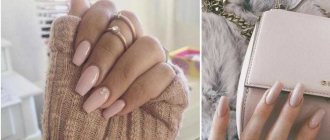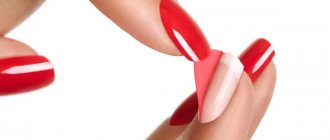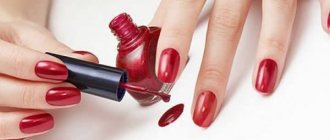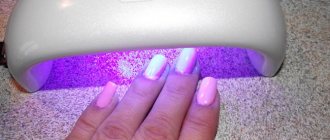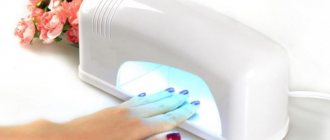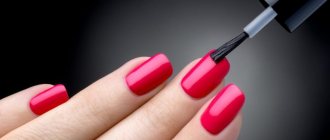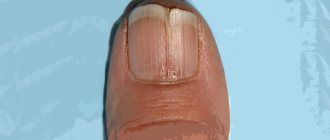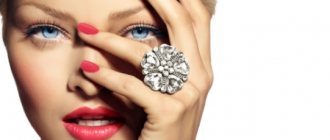The gel polish in the lamp does not dry when using counterfeit/low-quality materials, lighting equipment with low power or faulty elements, or when the lamp is heavily soiled. Professionals recommend first of all paying attention to the quality of gel polishes, especially since there is a list of materials that most often add difficulty to drying in a lamp - Noname, Lianail, Bluesky and others.
Any problems with poor drying of gel polish in a lamp can be solved: change the manufacturer of the materials, provide them with the correct storage conditions, use only powerful lamps, and so on.
Why gel polish does not dry in a lamp: errors in technology
Most often, gel polish does not dry in the lamp due to improper manicure performance (improper positioning of the hand in the lamp, a thick layer of coating, residual stickiness, etc.), problems arise among newcomers to the nail industry, because the masters are well aware of the possible provoking factors.
The hand is positioned incorrectly in the lamp
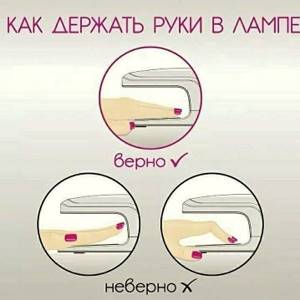
If the gel polish does not dry completely in the lamp, then you should pay attention to the position of your hand - the best option would be to dry each nail separately, but this takes too much time. Professionals carry out the drying stage of each layer taking into account the following points:
- Dry only the thumb separately;
- It’s better to place everything else in a lamp in groups of 2;
- Nails are placed to dry in the center of the light fixture;
- All fingers (except the thumbs) can be placed simultaneously in the lamp to “dry”.
And you need to make sure that your fingers are positioned inside the lamp, tightly adhering to the hard surface - even a slight misalignment can cause the gel polish to slip and not dry enough.
Too thick layer of gel polish
Each layer of coating should be thin, and novice artists try to hide imperfections in the treatment of the nail plate with a thicker layer. If there is too much gel polish on the nail, even the most powerful lamp will not be able to dry such a layer. Professionals recommend not to rush, but to apply 3-4 layers and dry each thoroughly.

An example of correct application of gel polish
Residual sticky layer
Often, beginning craftsmen complain that the top layer of gel polish, even after prolonged drying in a lamp, remains soft and pliable, although the overall polymerization of the decorative coating has taken place. This is how residual stickiness manifests itself - this phenomenon occurs often, and is corrected with a special liquid. But professionals warn that you need to use a cleaner for this manipulation, and not replace it with medical alcohol, acetone or nail polish remover.
If the general technology for performing a manicure with gel polish has been fully followed, but the top layer remains soft after drying, then you just need to moisten a cotton pad in a cleanser and wipe each nail plate - the coating will be perfect.
In addition to the reasons listed, you need to pay attention to the choice of gel polishes - there is an anti-rating for those that are difficult to dry in a lamp, even with the correct application of layers and ideal preliminary preparation of the nail plate.
Examples of bad varnishes

The most problematic gel polishes with regard to drying include:
- Noname made in China. Their popularity is due to their low cost, and even many buyers receive positive reviews about the quality of such products. But you need to understand that China produces counterfeits of well-known manufacturers and is unlikely to comply with technological processes during the manufacture of products. The result can be completely unpredictable; often the gel polish spreads, practically does not polymerize, and becomes covered with cracks.
- Gelish gel polish is a decorative coating from an American brand. In general, this material is famous for its high quality characteristics, but it also has disadvantages. For example, sometimes there are complaints from professionals that the first layer of this gel polish “curls” a little when drying, even if a branded base coat was previously applied.
And one more nuance regarding this brand of gel polish - the white color of the coating polymerizes very poorly, so you have to significantly increase the drying time in the lamp. It’s interesting that other shades of gel polishes “behave” absolutely adequately.
- Lianail is a well-known brand, its popularity at one time was simply incredible, because the quality-to-price ratio of gel polishes was simply ideal. Over time, complaints began to be received that when applying the next layer, the brush began to get dirty with the previous one, and the last one “stretched” behind the lint.
Even experienced craftsmen reported this, but a priori they could not disrupt the technology of drying gel polish in a lamp. Afterwards, professionals adapted to solve this problem by increasing the drying time of each decorative layer in the lamp.
- Ingarden - the range of gel polishes from this manufacturer is simply huge; the line always includes the most popular shades. But users often complain that when removing a sticky layer and applying a subsequent one, the previous one may shift. The solution to the problem is simple - you need to increase the drying time for each layer of decorative coating to 2 minutes. This, of course, prolongs the time of manicure, but it turns out to be of very high quality.
- Bluesky is a well-known brand, but with one caveat: light shades take much longer to dry than dark ones. In general, it is believed that the materials from this manufacturer will be easiest to use for professionals who can properly dry gel polish in a lamp with ultraviolet light.
Why does gel polish shrink, wrinkle, and curl up in the lamp?
If the gel polish shrinks, wrinkles, or curls after drying the nails in the lamp, then the reason must be sought directly in the material used:
- highly pigmented color - these will be bright, “dense” shades, in which a high concentration of pigment prevents the penetration of light rays, which prolongs the polymerization process;
- the shelf life of the gel polish has expired - it is usually calculated from the moment the bottle is opened (2 years), after this time the material not only dries poorly in the lamp, but also does not stick to the nails and can cause allergies (such residues are better used on tips);
- gel polish has not been used for a long time - the pigment in the bottle has already settled to the bottom, the composition becomes uneven, and this does not allow it to dry well, but if you carefully roll the bottle in your palms, the problem will disappear (it is strictly forbidden to shake it - bubbles will appear in the varnish, which then they will remain on the nails);
- the decorative coating was not stored correctly - the place should be dark and not hot so that the gel polish does not thicken and lies evenly on the nail plate.
Cheap gel polish, an outright fake of well-known brands, shrinks, curls and wrinkles in the lamp. That is why it is recommended to purchase truly branded decorative materials from suppliers with an impeccable reputation.
How to choose a curing lamp
The market offers hundreds of options for lamps for nail services, which can make you feel confused. But if you know the basics, the choice becomes obvious.
All lamps offered by the beauty industry are divided into two groups:
- Light-emitting diode (LED);
- Luminescent (UV).
They also differ in power rating (measured in W). If you don’t want to rack your brains over various problems later, choose the type of lamp depending on its characteristics, your goals and operating characteristics. Below we present the fundamental pros and cons of each type of lamp.
Why does the lamp not dry the gel polish, it is soft after drying
If after drying the gel polish remains soft, but there are no bubbles or signs of wrinkling, then most likely the problem lies in the lamp. First of all, you need to check how correctly the light sources work - often it is enough to replace 1-2 light bulbs to restore the drying power of the gel polish.
Lamp quality
The lamp can be ultraviolet, light-emitting diode (LED) or hybrid. Professionals recommend choosing hybrid types of equipment, but beginners in the nail industry can use simple UV lamps. It is important that the lamp has a power in the range of 16-36 W, and what light elements it will be equipped with depends on the requirements of the master. The fact is that some gel polishes are dried only under LED lamps, while there are materials for drying exclusively in ultraviolet equipment.
Watch the video on how to choose a lamp for gel polish:
It should be borne in mind that on average a lamp is designed for 3 thousand hours of operation, but some equipment serves trouble-free for six months even with hyperactive use. Ultraviolet lamps wear out the most, so after 1 month of use you need to check the equipment and, if necessary, change the light elements. You can tell that the lamp's life has been exhausted by increasing the drying time of the gel polish.
Presence of contamination
The cleanliness of the lamp for drying gel polish is not only a demonstration of neatness and neatness to clients, but also the key to long-term, impeccable service of the lighting equipment. Even a slight layer of dirt and dust on the lamp can cause a decrease in the efficiency of drying the decorative coating. Professionals recommend wiping equipment daily with adhesive remover for medium levels of dirt and nail polish remover for heavy levels.
Equipment power
LED and fluorescent devices have higher luminous energy. At the same time, they use less electricity.
The energy consumed by UV drying to harden the coating on the entire hand is from 36 to 54 W, Inert tubes take 12-18 W, LEDs - from 9 to 12 W.
To use low-power devices, it is necessary to reduce the working area. For one finger, a 9 W UV lamp will handle the fixation. At a time when such a lamp for the fingers of the entire hand may turn out to be rather weak. The varnish will not harden. The speed and quality of fastening will be better from a device that produces light of the required range and greater intensity.
How to tell if gel polish is dry and how long does it take to dry?
Gel polish does not dry for long - it is enough to keep your nails in an ultraviolet lamp for 60 seconds at a power of 36 W, if the latter figure is lower, then the time can increase to 2 minutes. But you can understand that the gel polish has really dried by the following signs:
- the coating does not shine;
- the color of the gel polish is uniform;
- when turning the finger down with the nail, there are no symptoms of “floating” of the material.
Beginners can check the degree of dryness of the decorative coating with liquid to remove the sticky layer - if no pigment remains on the cotton pad, then the process has been successfully completed.
Dispersion layer
This information will be useful only to beginners. If this is your first time using gel coatings, after drying you may encounter the following problem: the surface of your varnished nails is sticky, even seemingly soft. It seems as if the varnish has not dried at all...
Emotions aside! As reviews from eminent masters say, most likely, this is not about poor drying, but about residual stickiness. About the dispersion layer, if we speak in pro language. This is a normal phenomenon, there is absolutely nothing to worry about. Just cover the nail with a layer of top coat and dry it in a lamp.
By the way, most topcoats also have a dispersion layer. You just need to remove it with a lint-free cloth soaked in a special liquid.
Why doesn't the base or top coat dry?
The base and top coat may not dry if the technology of the preparatory stage is violated, because the base rests on the natural nail plate. The most important thing is to thoroughly degrease the surface so that the rays of ultraviolet lamps can penetrate the base layer and “glue” it to the nail with heat.
The top does not dry often when:
- use of low-quality materials;
- the use of LED lamps (the top dries only under ultraviolet light);
- the time the hand is in the lamp is too short.
Gel polish does not dry in the lamp: reasons and ways to prevent them
The most common reason that gel polish does not dry in the lamp is that its expiration date has expired.

The photo shows an example of expired gel polish
Manufacturers indicate that their products can be used for 2 years, but this period should be counted not from the date of manufacture, but from the moment of opening/first use. It is also important to store gel polish correctly - away from heating devices, in a dark place.
These factors most often “work” on those varnishes that have too extravagant shades or are not popular. It will not be possible to solve the problem of expiration date, but a long break in the use of a particular material makes it necessary to carefully roll it in your palms before opening the bottle. It is strictly forbidden to shake such varnishes - the pigment will be distributed unevenly in the varnish, as a result the coating will be of poor quality.
How to apply thick varnishes correctly
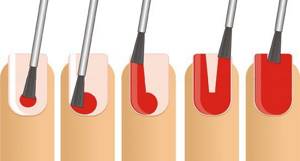
Many gel polishes contain a large amount of pigment - their colors are rich and bright. Professionals emphasize that such material should be applied with an absolutely dry brush and in an extremely thin layer - in general, it is better to apply 2 ultra-thin layers and dry them step by step than to get by with one “thin” one, reducing the time of the entire manicure.
If a thin layer was applied, but the gel polish still shrank and wrinkled after drying in the lamp, then this means that the thickness needs to be reduced. The application of ultra-thin layers of coating of highly pigmented materials also reduces their consumption, and at the prices of branded products this is relevant.
How to care for dryer lamps
You need to clean the equipment every day after finishing work, but change the light bulbs much less often - no more than once every 5-6 months, if you work with them every day and for 2-3 manicures.
In order for the gel polish to dry completely, you need to monitor the condition of the light elements - simply look inside the structure and identify those lamps that shine weaker or have gone out completely. This applies to all types of equipment, especially hybrid ones - if the master dries the coating for 60 seconds, then if only one element fails, the time should be increased. And if this does not happen, then the gel polish may not dry completely under the same working conditions.
Too thick layer
Masters know, but beginners may not know, that it is better to apply 2-3 thin layers than one thick one.
If you have covered your nails with an impressive layer of varnish, it may not dry well. There is no reason to be upset: remove the coating and get ready for meticulous work. Apply thin layers and let each layer dry. Most likely, the problem will resolve itself.
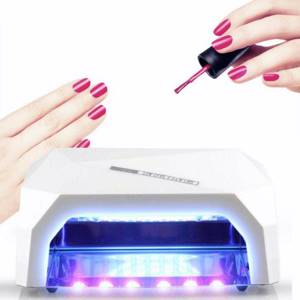
What happens if you overdry gel polish in a lamp?
In general, there is no such thing as “over-drying gel polish in a lamp”, because after the decorative coating hardens, all reactions stop, further influence of ultraviolet or LED waves does not have a negative impact on the final result. Even if the nails were in the lamp for 4 minutes instead of the required 2, then subsequently there will be no chips, cracks or a decrease in “use time”.
If the gel polish does not dry in the lamp, then you need to look for the reasons in the material itself, the lamp and the rules of the process technology. The process can be affected by low power of lighting equipment, low-quality or too light/highly pigmented varnish, severe contamination of the lamp, lack of a degreasing stage of the nail surface and other factors. When eliminating “provocateurs”, the process of drying gel polish in a lamp can be adjusted to perfection.
My observations
In addition to timely replacement of lamps, I would also recommend paying more attention to its care: wipe the mirror surface from below and do not allow it to accumulate dust and dirt. It is not for nothing that it is made mirror - it reflects UV rays, helping them to dissipate in the lamp and dry the gel polish faster.
By the way, after replacing the lamp from UV to LED, this problem ceased to exist. Even to take a photo for the screensaver for this article, I repainted about 30 tips with my oldest gel polishes
That's all, my dears! There are not many reasons and, as you can see, they are all easy to avoid. Next time I propose to discuss the problem of why gel polish bakes in a lamp. Well, write your topics in the comments, what interests you or doesn’t work for you?
